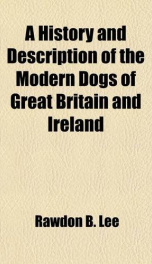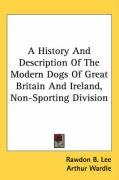a history and description of the modern dogs of great britain and ireland the

Purchase of this book includes free trial access to www.million-books.com where you can read more than a million books for free. This is an OCR edition with typos. Excerpt from book: CHAPTER II. THE BULL TERRIER. OUR modern bull terrier is a very different creature from what he was half a century ago, and I know there are some old " dog fanciers" who prefer the brindled and white and fawn or fallow smut dogs, that were so often kept in our grandfathers' days, to the " milk-white " animals now seen on our show benches. There is little or no doubt that the original bull terrier was a cross between an ordinary kind of terrier and the bull dog, and some of the largest specimens had a touch of the mastiff thrown in. He had been bred for fighting or for killing rats, and, long before the era of canine exhibitions, some of the rougher so-called sporting men in London and in the Midlands, of which Birmingham may be taken as the metropolis, had strains of more or less celebrity. The dogs that fought with Wombwell's lions at Warwick in 1825 were large bull terriers, and not bull dogs, as stated in the journals of thatday, and the fighting dogs of that time and now (for this brutal sport is still followed in many places) were and are bull terriers. The old-fashioned dog was a much more cumbrous brute than finds favour at the present time, and his colour varied. For instance, James Ward painted one in 1808 that was evidently black and tan, with white on him, a favourite dog of his own, and of a strain highly valued for its courage. This dog had its ears closely cropped, in order, of course, that they might not be in the way of an opponent's teeth when fighting. A little later Marshall painted another bull terrier, black, white, and tan, a dog which the great foxhound authority, Squire Meynell, pronounced to be from one of the best strains he ever knew. The back numbers of the Sporting Magazine contain many representations of the bull terrier, and it is stated...
Info about the book
Author:
Series:
Unknown
ISBN:
0548555850
Rating:
4.5/5 (5)Your rating:
0/5
Languge:
English
Users who have this book
Users who want this book
What readers are saying
What do you think? Write your own comment on this book!
write a commentGenre
if you like a history and description of the modern dogs of great britain and ireland the try:
Do you want to read a book that interests you? It’s EASY!
Create an account and send a request for reading to other users on the Webpage of the book!



